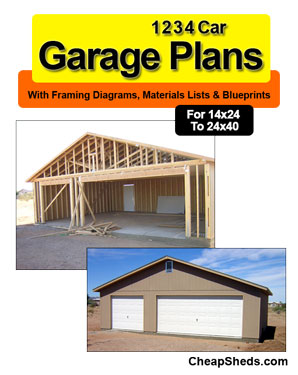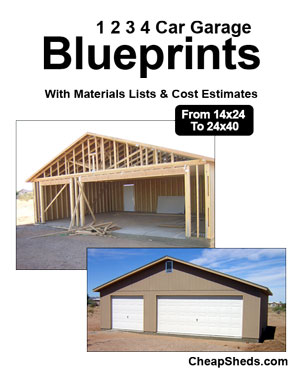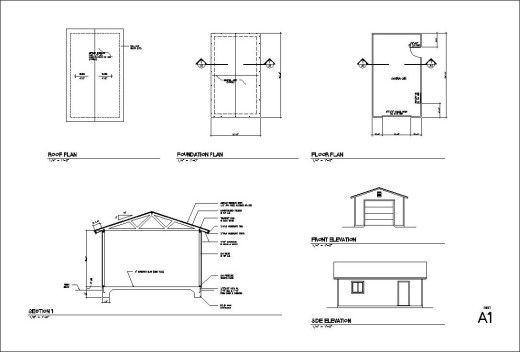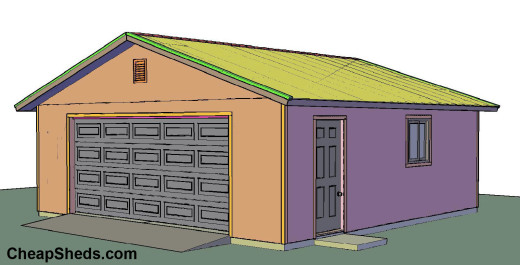24x32 Garage Plans + Blueprints


Buy Now - $19.95

These plans give you step by step framing instructions, complete with diagrams and dimensions.
They are designed for the first time garage builder with little or no construction experience.
Includes These 4 Garage Sizes:
This number represents the maximum number of cars you can park inside.
- 1 Car, 14x24
- 2 Car, 24x24
- 3 Car, 24x32/32x24
- 4 Car, 24x40
You don't have to put all these doors in. You can use fewer doors if you like and have more space left over for other storage. Or add benches and have some nice shop and work space.
14x24 1 car garage
This garage has an 8x7 ft overhead door centered on the 14 ft gable end wall. You can install a 36 inch pass door and any number of windows on the other 3 walls.
24x24 2 car garage
There is a 16x7 ft overhead door installed on the center of any one of the 4 walls. You can install a 36 inch pass door and any number of windows on the other 3 walls.
This garage is square so you can install the overhead door on the gable end wall or a sidewall, depending on the look you want.
24x32/32x24 3 car garage
The difference between a 24x32 and 32x24 garage is the orientation of the trusses and ridge line. Both garages have a 16x7 and a 8x7 overhead door on the 32 ft wall.
The 24x32 uses 24 ft trusses and the ridge line runs along 32 ft dimension. The 32x24 garage uses 32 ft trusses and the ridge line runs along the 24 ft dimension.
24x40 4 car garage
This garage uses 24ft trusses. The 40 ft side wall has 2) 16x7 ft overhead doors and you can install a 36 inch pass door and any number of windows on the other 3 walls.
Each garage size includes this information:
- Notes on material usage
- Cost estimate worksheet and detailed materials list
- Instructions to customize the "blank" plans
- Blueprints: Typical layout with doors and windows marked
- Blueprints: Blank with floor
- Blueprints: Blank without floor
1) Notes on materials usage
These notes will help you understand the components of the materials list and cost estimate worksheets.
2) Cost estimate worksheet
Print the cost estimate worksheet of the desired garage size and take it down to your lumber supply store. Fill in the prices to calculate the materials cost for the garage shell. The detailed materials lists shows how the wood is used in each of the 4 walls and the roof structure.
3) Instructions to customize blank plans
Use Table A and Figure 1 and fill in the blanks to make any garage layout you prefer. Write directly on the printed blueprints with a black pen. Make a few extra blank copies in case you make a mistake.
4) Blueprints: Typical Layout
These plans can be used as is if you like the door and window configuration. Or you can use them as a sample guide to mark the blank plans to your satisfaction.
5) Blueprints: Blank with floor
These plans don't include any doors, windows, roof pitch, wall heigh, or dimensions and allow you to draw in any combination, location, and quantity of overhead doors, pass doors, and windows, etc..
Use the Typical layout as a guide to customize this blank blueprint to your specifications.
6) Blueprints: Blank without floor
Standard floor and foundation is a mono-pour concrete slab. But with these blank plans you can provide your own supplemental diagram and build with a wood floor or a stem wall and concrete slab.
Additional notes
- Building codes
- Additional engineering
- Blueprint size and format
Building codes
These blueprints will meet building codes in most cases. But sometimes additional information is required that can usually be hand written on the blueprints with the guidance of your local building department staff.
Most of the time just a few hand written changes or additions is all it takes to make the building department happy. They are usually pretty understanding with homeowners with little or no experience in the building permit process and will tell you exactly what they want in order to approve the plans.
Additional Engineering
If your building department requires engineering for the trusses or custom header, that information is typically built into the price of the trusses or header.
Additional engineering might be required if you live in an area with extreme weather like lots of rain, snow, humidity, wind or seismic activity.
Blueprint size and format
The printed size of the blueprints are 36"x24".
Blueprints are in PDF format so you will have to print them out yourself. You can open them in a standard PDF reader and print them out in 8.5x11 size.
But you will have to go to a print shop to have them printed out in full 36"x24" size. Most print and blueprint shops can do this for about $1-$2 per copy. They can even re-scan them back into PDF format after you have marked them up to your specifications.
Blueprints look like this...
Blueprints condense the information necessary to build a garage into a standard format for other people's use.
They are necessary for working with contractors or getting building permits.


Buy Now - $19.95
Typical layout for a 24x24 - 2 car garage
 .
.
Highlights:
These plans are for framing a garage with:
- Wall height: 8ft standard, 9-12ft optional
- Stud spacing: 16 inch on center
- Stud size: 2x4 standard, 2x6 optional
- Roof style: Gable
- Roof covering: Shingles standard, optional: metal, rolled, built up
- Trusses: Manufactured, available at most any lumber yard or truss company
- Maximum overhead door opening height: 7 ft (with 8 ft wall height), up to 11 ft (12 ft wall height)
- Floor: Monopour concrete slab standard, optional: wood, stem wall with concrete slab
Blueprints
- Matching blueprints: Necessary for obtaining building permits
- Sizes: 1 car (14x24), 2 car (24x24), 3 car (24x32/32x24), 4 car (24x40)
Building Instructions: Table Of Contents
- General information
Instructions
- Planning and design
- Estimating the cost
- Building permits and legal issues
- Location and site prep
- Foundation and floor
- Frame walls
- Frame for doors and windows
- Trusses and roof structure
- Install doors, windows, trim, and paint
- Shingle roof
- Accessories: Plumbing, electricity, insulation, drywall
Tables
- Table 1: Materials lists and cost estimate worksheets, moved to Appendix A
- Table 2a: Wall stud lengths for various wall heights
- Table 2a: Notes
- Table 2b: Top and bottom plate dimensions
- Table 2a: Notes
- Table 3: Number of pieces for floor joists, wall studs and trusses
- Table 4: Nailing schedule
Figures
- Figure 6.01a, Wall stud detail, for wood floor
- Figure 6.01b, Wall stud detail, standard wall height
- Figure 6.o1c, Wall stud detail, 10 or 12 ft wall heights
- Figure 6.02, Typical inside & outside wall layout
- Figure 6.05a, Outside wall framing detail
- Figure 6.05b, Inside wall framing detail
- Figure 6.05c, Corner layout detail, 2x4 vs 2x6 wall studs
- Figure 7a, Window framing detail
- Figure 7b, Pass door framing detail
- Figure 7c, Overhead door outside wall framing detail
- Figure 7d, Minimum space between openings
- Figure 8.03, Flying rafter cut out & spacing
- Figure 8.or First truss mark and spacer board
- Figure 8.06, Truss and roof framing components detail
- Figure 8.06b, Splice truss end boards detail
Buy Now - Instant Download
In addition to these plans in pdf format you also get:
- Email help with all of your garage building questions
- If you aren't happy with the plans for any reason just send me an email and I will refund the purchase price.


Garage Plans & Blueprints
